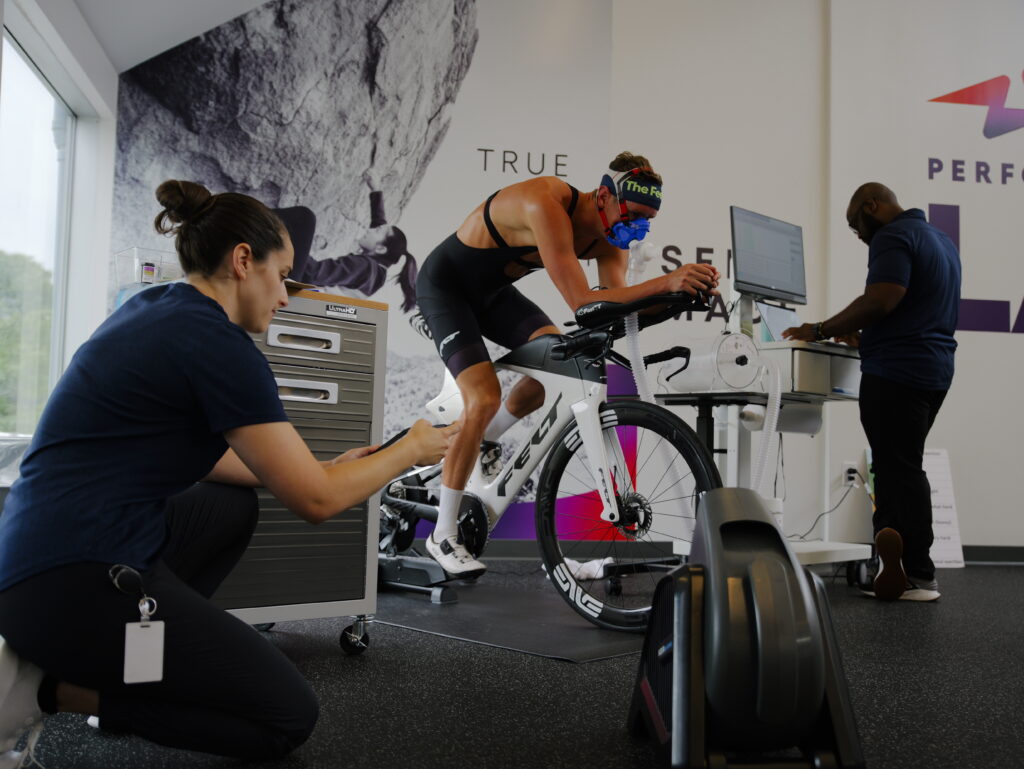VO2 max testing is rapidly gaining attention in the health and fitness world as a crucial measure of cardiovascular health and longevity. With more people tracking their VO2 max, a common question arises: Is running the only way to assess this critical metric?
Keep reading to explore VO2 max testing in depth and the different methods used to measure it.
VO2 max refers to maximal oxygen consumption, a key component of aerobic fitness. It measures the maximum level of oxygen that a person’s body can use during exercise. VO2 max reflects the efficiency of your cardiovascular and respiratory systems in supplying oxygen to your muscles and how effectively those muscles can use that oxygen for energy production.
Your VO2 max depends on a few key components, including age, gender and fitness level. VO2 max gives a detailed insight into your aerobic endurance and overall fitness level. For this reason, it is considered the gold standard in longevity.
A lab-grade VO2 max assessment is quick, with the average test being completed in 6-15 minutes, depending on the individual. The VO2 max test measures how many milliliters of oxygen your body uses per kilogram of body weight each minute. During the test, exercise intensity gradually increases while heart rate, breathing rate and oxygen consumption are closely monitored.
While equipment used for a VO2 max test can vary, a metabolic cart is essential for obtaining accurate results. The testing protocol, however, changes depending on whether the test is performed on a treadmill or a stationary bike.
During a treadmill-based VO2 max test, the intensity increases progressively by adjusting the speed, incline or both. In contrast, a VO2 max test on a bike increases in difficulty solely through resistance adjustments over time. Depending on an athlete’s goals, our performance physiologists tailor specific protocols to suit each individual, ensuring the most effective and reliable assessments.
But this raises the question: Why would you test your VO2 max on a bike?

A VO2 max test on a bike is often chosen over a treadmill for two primary reasons: an athlete’s main training modality and safety considerations
For cyclists, using a bike for the test ensures the results are more reflective of their actual aerobic fitness. Since VO2 max is highly specific to the activity an individual regularly engages in, a cyclist would likely achieve a higher VO2 max on a bike than on a treadmill because their body has adapted to cycling-specific demands.
This adaptation includes improved neuromuscular efficiency and greater endurance in the cycling motion, which would not be as evident in a running-based test.
The second reason for selecting a bike over a treadmill is when an individual is unable or hesitant to run or walk at an incline. While weight-bearing activities like running engage more muscles groups and can provide a more comprehensive assessment of aerobic capacity, they may not be safe for certain populations.
Individuals with joint issues, mobility limitations, or concerns about balancing on a treadmill at increasing speeds may find a bike test to be a safer alternative.
Since a VO2 max test is a maximal effort assessment, ensuring comfort and safety is crucial. In such cases, physiologists can still accurately determine whether the individual has reached a true maximal effort by analyzing breathing rate stability, allowing for meaningful insights and recommendations based on the test results.

Remember that data from wearable technology is estimated and often misses key components of a true VO2 max measurement. For those tracking their VO2 max or who have completed formal testing, it’s common to notice differences in results between running and cycling.
The main difference lies in the muscle groups used during treadmill running versus cycling. VO2 max values typically vary by 5-10% between weight-bearing and non-weight-bearing activities. However, for individuals who primarily train through cycling, their VO2 max on the bike is likely a true reflection of their aerobic capacity.
A good rule of thumb is the more muscles involved in an activity, the higher the likely VO2 max, provided the individual has the necessary lactate clearance and muscle endurance to sustain the effort.
Exercises that require standing upright engage more muscles for stability and movement, which, in turn, increase the body’s demand for oxygen to support those working muscles.
If you’re struggling to find VO2 max testing near you, look no further. With Performance Labs in Minneapolis, Boston and Scottsdale, we are making this beneficial testing more accessible than ever.
Our expert performance physiologists use state-of-the-art technology to guide you through each test. You’ll receive a personalized breakdown of your results, tailored to your unique goals and physiology, along with clear and actionable recommendations for improvement.
Human Powered Health is staffed with Master's and PhD-level performance physiologists who are dedicated to helping you improve your health and performance. Our product is a healthier you, and we have the science to make you better than ever.
Human Powered Health uses high-precision, research-grade technology for all assessments in order to provide a superior level of service and quality for anyone who wants to learn more about their health and performance metrics.
We are on a mission to power health and athletic performance for motivated humans. Your body belongs to you. You deserve accurate information about it. We give everyone the data and expertise to fine-tune their own health and athletic performance. Because knowledge is power, and true health is self-made.